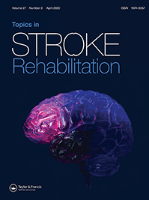
Topics in Stroke Rehabilitation
Scope & Guideline
Fostering collaboration in stroke recovery strategies.
Introduction
Aims and Scopes
- Stroke Rehabilitation Techniques:
The journal covers various rehabilitation techniques including physical therapy, occupational therapy, and speech therapy, emphasizing innovative approaches and their effectiveness in improving functional outcomes for stroke patients. - Assessment and Measurement Tools:
Research on the development and validation of assessment tools to evaluate stroke recovery, including psychometric properties of scales and innovative technologies for monitoring progress in rehabilitation. - Multidisciplinary Approaches:
Emphasis on the collaboration between healthcare professionals from various fields to provide comprehensive care and support for stroke survivors, addressing both physical and psychological aspects. - Patient and Caregiver Perspectives:
Studies exploring the experiences and needs of stroke survivors and their caregivers, focusing on their involvement in rehabilitation processes and the impact of their social support networks. - Emerging Technologies in Rehabilitation:
Research on the integration of new technologies such as virtual reality, robotics, and artificial intelligence in stroke rehabilitation to enhance traditional therapeutic approaches.
Trending and Emerging
- Telehealth and Digital Interventions:
The rise of telehealth solutions and digital platforms for rehabilitation has gained traction, reflecting an increasing reliance on remote care and monitoring, especially in the context of the COVID-19 pandemic. - Interdisciplinary Research and Collaboration:
There is a growing trend in studies that involve collaboration across multiple disciplines, indicating a comprehensive approach to stroke rehabilitation that integrates various professional insights and expertise. - Focus on Quality of Life and Community Reintegration:
Recent studies emphasize the importance of quality of life and social participation post-stroke, highlighting the need for rehabilitation strategies that facilitate community reintegration and support survivors' overall well-being. - Innovative Exercise Protocols:
Research is increasingly exploring novel exercise regimens and physical training techniques, such as high-intensity interval training and robotic-assisted rehabilitation, showcasing a shift towards more dynamic and effective rehabilitation practices. - Cultural and Contextual Adaptations:
There is an emerging focus on culturally sensitive rehabilitation practices and assessments tailored to diverse populations, reflecting a recognition of the importance of context in stroke recovery.
Declining or Waning
- Traditional Rehabilitation Modalities:
There is a noticeable decrease in studies focusing solely on traditional rehabilitation methods without incorporating new technologies or interdisciplinary approaches, suggesting a shift towards more innovative strategies. - Longitudinal Studies on Stroke Recovery:
Research that traditionally tracked long-term outcomes of stroke recovery has become less frequent, indicating a potential waning interest in longitudinal methodologies in favor of more immediate and actionable research findings. - Generalized Psychological Interventions:
While psychological health remains critical, the focus on generalized interventions without specific adaptations for stroke populations is decreasing, as more targeted and evidence-based psychological approaches are being prioritized.
Similar Journals

Journal of Neurologic Physical Therapy
Empowering Practitioners in Neurologic Physical TherapyJournal of Neurologic Physical Therapy, published by Lippincott Williams & Wilkins, stands as a premier resource in the field of physical therapy with a specific focus on neurology. With an ISSN of 1557-0576 and an E-ISSN of 1557-0584, this journal serves as a vital platform for researchers, practitioners, and students from 2004 to 2024, illustrating its commitment to advancing knowledge in neurologic rehabilitation. It holds a prestigious Q1 ranking in categories such as Physical Therapy, Sports Therapy, and Rehabilitation and Rehabilitation, alongside Q2 rankings in Geriatrics and Gerontology, Medicine (Miscellaneous), and Neurology (Clinical). With an impact factor that reflects its significance, the journal hosts comprehensive studies and clinical insights that propel practice and innovation in neurologic physical therapy. The content is designed to enhance understanding and skills, making it an indispensable resource for those dedicated to improving patient care and outcomes in this critical area of health.
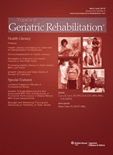
TOPICS IN GERIATRIC REHABILITATION
Fostering Excellence in Geriatric Rehabilitation ResearchTopics in Geriatric Rehabilitation is a premier scholarly journal dedicated to advancing the field of geriatric rehabilitation, published by Lippincott Williams & Wilkins. With the ISSN 0882-7524 and an E-ISSN of 1550-2414, the journal has been a vital resource since its inception in 1985, providing a platform for innovative research and clinical studies that address the rehabilitation needs of older adults. It features a diverse range of articles that contribute significantly to the understanding of geriatric care practices, physical therapy, and rehabilitation strategies. Although currently categorized as Q4 in Geriatrics and Gerontology and Q3 in both Physical Therapy, Sports Therapy, and Rehabilitation, and general Rehabilitation, the journal continually strives to improve its scholarly impact and visibility within the medical community. The journal's eclectic content is invaluable for researchers, clinicians, and students alike, aiming to foster a better understanding of geriatric rehabilitation and improve health outcomes for older populations. With plans for expansion in open access options and a commitment to high-quality peer-reviewed content, Topics in Geriatric Rehabilitation remains dedicated to supporting advancements in this crucial field.
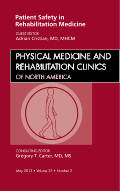
Physical Medicine and Rehabilitation Clinics of North America
Exploring the forefront of physical medicine and rehabilitation.Physical Medicine and Rehabilitation Clinics of North America is a leading journal published by W B Saunders Co-Elsevier Inc., focusing on the multifaceted disciplines of physical medicine, rehabilitation, and related health professions. With an impressive impact factor reflecting its significant contribution to the field, this journal ranks in the Q2 quartile for both Physical Therapy and Rehabilitation categories. The journal, available in both print (ISSN: 1047-9651) and online (E-ISSN: 1558-1381), provides critical insights, clinical updates, and comprehensive reviews that are essential for researchers, practitioners, and students alike. Covering a wide spectrum of topics from innovative rehabilitation techniques to emerging trends in sports medicine, it aims to disseminate knowledge that enhances patient care and drives advancements in rehabilitation practices. With a publication history spanning from 1995 to 2024, Physical Medicine and Rehabilitation Clinics is an essential resource for those dedicated to improving functional outcomes and the quality of life for patients worldwide.
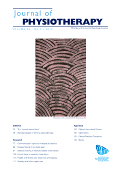
Journal of Physiotherapy
Unleashing Potential: Your Gateway to Physiotherapy ExcellenceThe Journal of Physiotherapy, published by the Australian Physiotherapy Association, is a leading peer-reviewed journal dedicated to advancing the field of physical therapy, sports therapy, and rehabilitation. With a stellar impact factor and ranked Q1 in the 2023 category of Physical Therapy, this journal serves as an essential resource for researchers, clinicians, and educators alike. Located in Australia, it features open access options that allow global dissemination of knowledge, enhancing the visibility of cutting-edge research from 2010 to 2024. With a commendable Scopus Rank of #5 out of 247 in its field, achieving the 98th percentile, the Journal of Physiotherapy is committed to enriching the evidence base within the profession and promoting best practices in physiotherapy. Whether you are searching for the latest clinical studies, innovative treatments, or comprehensive reviews, this journal provides a platform for high-quality scholarship that drives the profession forward.
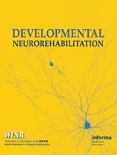
Developmental Neurorehabilitation
Fostering interdisciplinary dialogue in developmental care.Developmental Neurorehabilitation is an esteemed journal published by Taylor & Francis Inc, dedicated to advancing the field of developmental neuroscience and rehabilitation. With an ISSN of 1751-8423 and an E-ISSN of 1751-8431, this journal serves as a vital resource for researchers, clinicians, and students interested in innovative therapeutic approaches and rehabilitation techniques for children and adolescents. Since its inception in 1997, Developmental Neurorehabilitation has focused on disseminating high-quality research, contributing to a deeper understanding of recovery processes in developmental disorders, and facilitating interdisciplinary dialogue among professionals. With its recognition in Q2 and Q3 quartiles across prominent categories such as Pediatrics and Rehabilitation, it stands out as a pivotal publication in its field, boasting Scopus rankings that reflect its significant impact—ranked #53 in Rehabilitation and #139 in Pediatrics, among others. While maintaining a commitment to quality research, the journal does not currently offer open access but remains accessible through institutional subscriptions, further enriching the academic landscape with critical insights into rehabilitation methodologies for developmental challenges and promoting better clinical practices to improve patient outcomes.

Turkish Journal of Physical Medicine and Rehabilitation
Fostering collaboration for enhanced patient outcomes.Turkish Journal of Physical Medicine and Rehabilitation, an esteemed publication by BAYCINAR MEDICAL PUBL–BAYCINAR TIBBI YAYINCILIK, serves as a premier platform for the dissemination of cutting-edge research in the fields of physical therapy, sports therapy, and rehabilitation. Established in 2018, this open-access journal has rapidly ascended within the academic community, boasting a commendable Q2 ranking in both Physical Therapy, Sports Therapy and Rehabilitation and Rehabilitation categories for 2023. With a significant Scopus rank reflecting its competitive standing, researchers and practitioners can access vital findings that advance clinical practices and enhance patient outcomes. Located in Istanbul, Turkey, the journal not only emphasizes accessibility but also encourages contributions that address the evolving challenges in the realm of physical medicine. As it continues to grow, the journal aims to foster a collaborative research environment, engaging both established and emerging scholars in the exploration of innovative rehabilitation strategies and methodologies.

Annals of Rehabilitation Medicine-ARM
Transforming Rehabilitation Practices with Quality ResearchAnnals of Rehabilitation Medicine (ARM), published by the Korean Academy of Rehabilitation Medicine, is a distinguished open-access journal dedicated to advancing the field of rehabilitation medicine since its inception in 1977. With its E-ISSN 2234-0653, ARM aims to disseminate high-quality, peer-reviewed research that reflects both the breadth and depth of rehabilitation practices. As of 2023, the journal ranks in the Q2 quartile within the Rehabilitation category, placing it among the top half of journals in this domain, and it holds a respectable position in the Scopus rankings, being 70th out of 161 in the discipline. This journal emphasizes the importance of innovative research and clinical practices that improve patient outcomes in rehabilitation settings. Researchers, clinicians, and students alike will find valuable insights and the latest developments in rehabilitation science, enhancing their understanding and practice through its accessible content.
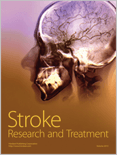
Stroke Research and Treatment
Elevating the discourse in stroke research and treatment.Stroke Research and Treatment is a premier Open Access journal published by HINDAWI LTD, dedicated to advancing the understanding and management of stroke and related neurological disorders. Since its inception in 2010, this journal has established itself as a valuable resource for researchers and clinicians in the field of neurology, providing a platform for high-quality, peer-reviewed articles that aim to improve patient outcomes and stimulate clinical practice innovations. With a 2023 Scopus ranking placing it in the Q3 category and a percentile ranking of 44th in clinical neurology, the journal is positioned to influence the ongoing discourse in stroke research. Stroke Research and Treatment embraces a global audience, with its editorial operations based in London, England. The journal's commitment to open access ensures that its content is freely available to all, promoting extensive dissemination and engagement in this critical field of study. Researchers, professionals, and students are encouraged to contribute their findings to this dynamic journal, fostering collaboration and knowledge sharing in the ongoing fight against stroke.

PHYSIOTHERAPY THEORY AND PRACTICE
Exploring Innovations in Physiotherapy and Sports TherapyPHYSIOTHERAPY THEORY AND PRACTICE is a leading journal within the realm of physical therapy, sports therapy, and rehabilitation, published by Taylor & Francis Inc. With an ISSN of 0959-3985 and an E-ISSN of 1532-5040, this esteemed journal focuses on the interdisciplinary approaches and clinical practices that advance the science and application of physiotherapy. Ranking in the top 33% of its category as indicated by its Q2 status in the 2023 category quartiles, it serves as an essential conduit for innovative research and evidence-based practices. The journal has been a vital resource since its inception in 1985, continuing to attract contributions that explore the latest developments in rehabilitation and therapy strategies. Although currently not an Open Access journal, PHYSIOTHERAPY THEORY AND PRACTICE remains pivotal in shaping the landscape of health professions, providing insightful articles that empower researchers, practitioners, and students to enhance patient care and treatment strategies in an evolving field.

Journal of Pediatric Rehabilitation Medicine
Shaping the Future of Pediatric Rehabilitation Through ResearchJournal of Pediatric Rehabilitation Medicine is a leading academic platform published by IOS PRESS, dedicated to advancing knowledge in the fields of pediatrics, rehabilitation, and physical therapy. With an ISSN of 1874-5393 and an E-ISSN of 1875-8894, this journal has carved a niche within the biomedical community, focusing on therapeutic innovations and evidence-based practices in pediatric rehabilitation. Recognized for its scholarly contributions, it holds a prestigious Q3 ranking in Pediatrics and Q2 rankings in both Physical Therapy and Rehabilitation categories, indicating its impact and relevance in the respective fields. Operating out of the Netherlands, the journal provides a comprehensive open access model that ensures that research is easily accessible to professionals, students, and researchers alike. With converged years spanning from 2007 to 2024, the journal continues to be an essential resource for those dedicated to enhancing the quality of life for children with disabilities and rehabilitation needs, fostering collaboration between clinicians and researchers through high-quality research dissemination.